
Water resources are important components for the development of human societies. Due to economic development and improvement of living standards, the problem of water resource scarcity has become prominent worldwide, which seriously limits the sustainable development of socioeconomics. The population growth in the world continues steadily. The United Nations has predicted that the world’s population will reach 9.7 billion by 2050, so the demand for water resources is becoming more intense (Wu et al., 2021).
Therefore, addressing the conflict between supply and demand in terms of resources is indeed essential. For this reason, designing water management strategies to address high levels of water stress and enhance environmental protection is considered essential. The scarcity of water resources and increasing competition among water users have led to the importance of water allocation (Fu et al., 2018).
One of the main measures of water resources management in any country is the allocation of water among nations, states, regions, water management organizations, and numerous water uses. Since there is usually not enough water of the required To meet the needs of various uses, decisions must be made about how to share it among users. Water resource allocation refers to the actions associated with these decisions. The water allocation mechanism refers to the process of distributing water resources to meet the different needs of water users (Vichete et al., 2023).
In this regard, there are four questions, which are who uses water resources, how, when, and where. Water allocation is a key global water management function that aims to maximize the social benefits derived from water. Social benefits can be classified as economic, social, and environmental, each with a corresponding principle—efficiency, equity, and sustainability, respectively. Efficiency means that scarce resources create the highest monetary value, equity refers to the appropriate distribution of wealth in society, and sustainability indicates a balanced relationship between the economy and the environment (Deng et al., 2022).
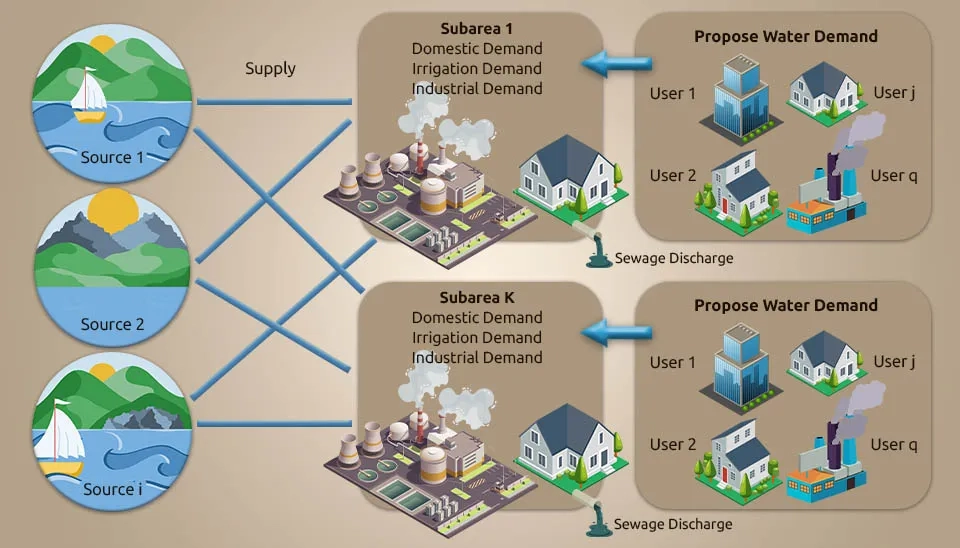
1. Criteria for Allocation
The allocation of water resources is a complex process that needs to meet the basic water demand of agriculture, industry, and domestic use, as well as to maintain the sustainability of the ecosystem. Appropriate allocation tools are essential to achieve optimal water resource allocation. Three important criteria of efficiency, equity, and sustainability are used to evaluate forms of water allocation.
1.1. Efficiency
As a resource, water can be consumed directly, such as for domestic use, or used as one of several factors in the production of other goods, for example, in the irrigation sector. In general, when resources are allocated in such a way that the value of their use is maximized, economic or allocative efficiency is achieved (White, 2018). For instance, efficiently allocating water to a direct consumable use requires maximizing its total value. This would be the case when the marginal values of water were equal among all consumable uses and users. Thus, it would be impossible to transfer water to where it had a higher marginal value. Similarly, in its use as a productive input, efficiency would be obtained if the value of the net economic product resulting from its use in the production process is maximized. This condition would occur when the value of the marginal productivity of water is equal among productive uses. Efficiency is the economic use of water resources. The term means that in deciding to allocate a unit of water, the sector that creates the highest benefit should be prioritized.
Economic efficiency has both spatial and temporal dimensions. In spatial allocation, efficiency requires that the marginal value of water utilized simultaneously in space be equal for all uses and users. When the discounted present value of water use in all periods is equal at the margin, optimal temporal efficiency is achieved. In other words, periods compete for resources as well as current uses (Ward and Pulido-Velázquez , 2008).

1.2. Equity
Equity concepts are related to how the total wealth is distributed among the members of the society. Social equity means that everyone has fair opportunities to access water resources. This includes equity between upstream and downstream areas. Of course, the equity index in water resources allocation not only pays attention to how water is distributed among people now but also considers future generations. Inequity in water allocation today means that large populations live in areas that do not have access to sufficient safe water, while millions of others use many times their basic minimum water needs for domestic purposes (Wallace et al., 2003). Undoubtedly, more equitable and sustainable policies for water management should address the complex reasons for this situation. Understanding water availability for different needs, uses, and functions in different seasons and climates and development scenarios is a key requirement for sustainable and equitable water allocation (Iftekhar and Fogarty, 2017). One of the most important indicators for measuring equity is the Gini coefficient.
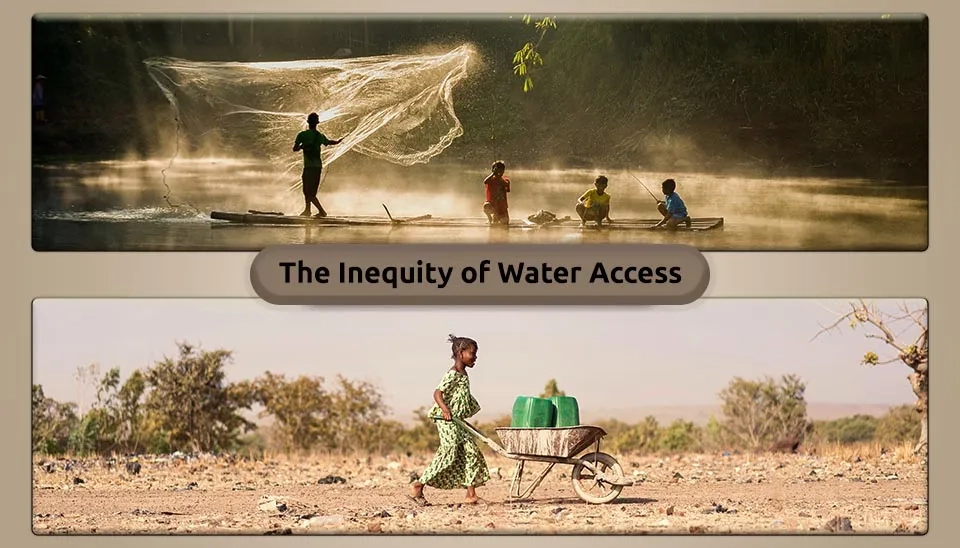
1.3. Sustainability
The concept of sustainable water resources management is the need to pay attention to the long-term future as well as the present. By its definition, sustainable development is the development that meets the needs of the present without compromising the ability of future generations to meet their needs (Loucks, 2009). Decision-makers regularly prioritize the inclusion of sustainability in water resource planning, emphasizing the need for sustainable resource allocation. Also, sustainable water resource systems are designed and managed in such a way that they maintain their ecological, environmental, and hydrological integrity. Unsustainable water use means loss of habitat function and biodiversity, especially in wetlands, ecosystem services such as drinking water supply, and regulatory services (Schlattmann et al., 2022).
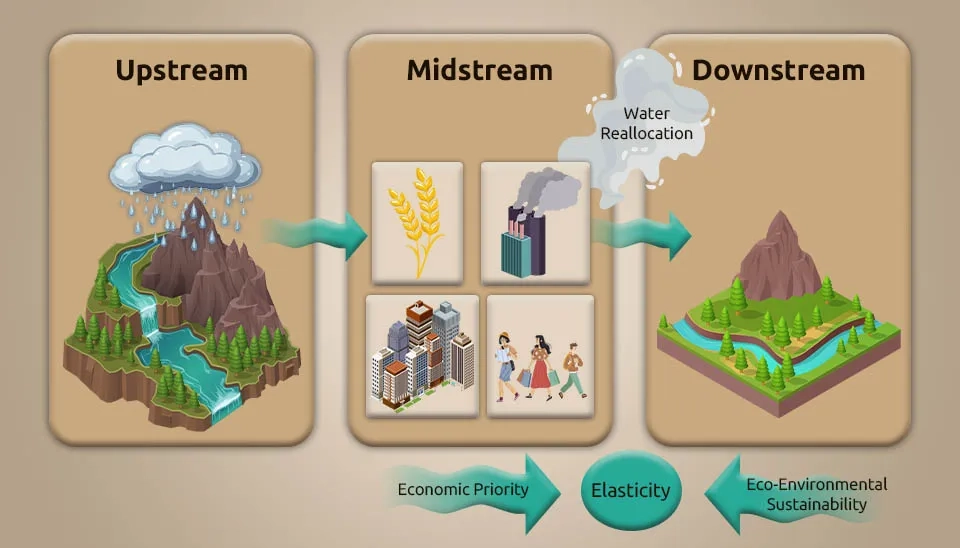
2. Key Considerations During Water Allocation
In this section, possible considerations of alternative mechanisms for the water allocation process among users at the regional, river basin, or conservation district level are mentioned, citing five factors derived from theory and experience.
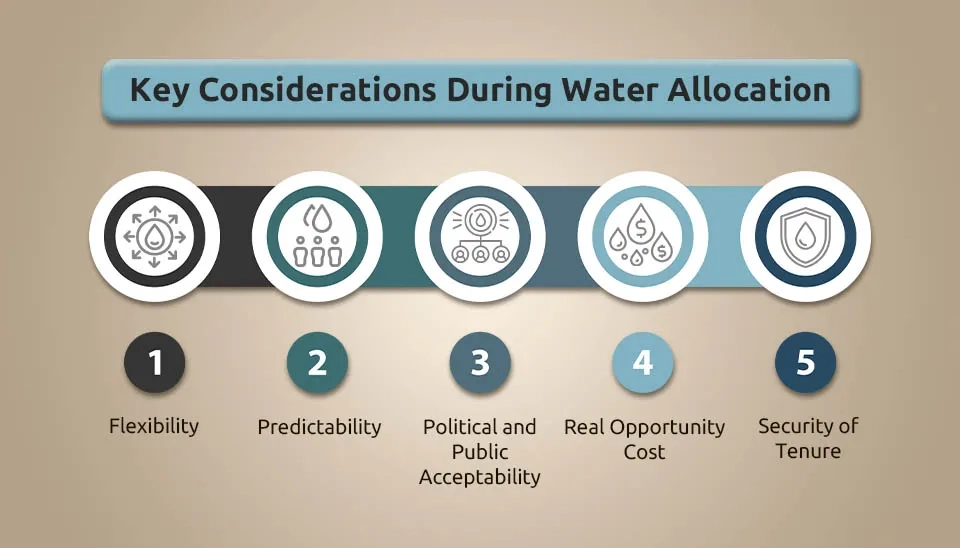
2.1. Flexibility
Occasionally the type of demand changes as resources are allocated. In these cases, not only can resources be shifted from use to use, but they can also be transferred to use in a new place (Zheng et al., 2014). In developing countries, designing and implementing flexible rules for adapting to periodic water supply changes are important as water shortages become more pronounced in the face of droughts and climate variability (Difrancesco and Tullos, 2014).
2.2. Security of Tenure
The users invest in and maintain water systems only if they ensure continued use, so in this case, they take the necessary measures to optimize the use of water resources. As long as users can voluntarily respond to water allocation incentives, security of tenure should not be incompatible with flexibility (Howe et al., 1986).
2.3. Real Opportunity Cost
It means whether the user faces the real opportunity cost of the resources available for their use. The real opportunity cost of supplying the resource is paid by users so that other demand effects or externalities are internalized. Opportunity cost is the benefit that is foregone from possible alternative uses of a resource, and any particular use of water will be associated with opportunity costs (Charles et al., 2017).
2.4. Predictability
The fourth factor is the predictability of the results of the water allocation process. It means that the best allocation can be realized. Although the older mechanisms of water resource allocation may be outmoded, because they are familiar to users and do not surprise them, they are trying to be preserved. Switching to a new allocation process, while promising some benefits, may increase uncertainty about the outcome (United Nations, 2003).
2.5. Political and Public Acceptability
The inherent characteristics of water make public intervention inevitable. To allocate water to its intended purpose, it must gain the political and public acceptance of different sections of society. If a policy is solving a serious problem, it is probably acceptable. If its costs and benefits are distributed fairly. Additionally, strong leadership from prominent political and social figures is crucial (Dinar et al., 1997).
3. Types of Water Allocation System
In this section, a brief definition of four methods of water resource allocation, including marginal cost pricing, public water allocation, water markets, and user-based allocation, is provided.
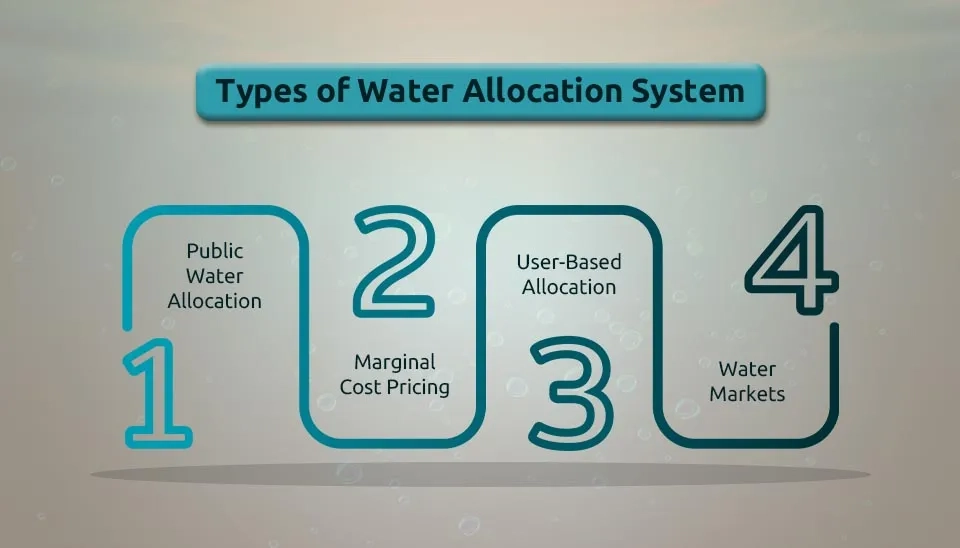
3.1. Marginal cost pricing
In summary, marginal cost pricing is a pricing strategy that sets the price of water equal to the extra cost of producing an additional unit of water. This approach only considers the additional costs of materials and direct labor for each unit of water sold. While marginal cost pricing is not a method to be used for normal pricing activities, it can be useful for certain situations (Zetland, 2021).
3.2. Public Water Allocation
Public water allocation is a process of distributing water supplies to meet the various requirements of a community. It is a mechanism for equitably apportioning water resources among users, protecting existing water users, governing the sharing of limited water, and facilitating efficient water use. However, public water allocation arrangements have limitations, and there is a need for an improved regime that can greatly increase the value that individuals and society obtain from water resources today and in the future (Erez, 2012).
3.3. Water Markets
Water markets are a mechanism for water resource allocation among users through voluntary exchange or transfer of a quantifiable water allocation between a willing buyer and seller. Water trading can promote more efficient water allocation and provide a clear measure of the value of water. Usually, resources will move from their uses at low values to the highest values. Therefore, market-based allocation is considered economically efficient from an individual and social perspective. In the case of water, several additional stipulations arise due to its unique characteristics. Occasionally it requires government intervention to create the necessary conditions for markets to operate. Such intervention includes (1) defining the original allocation of water rights, (2) creating the institutional and legal frameworks for trade, and (3) investing in the basic necessary infrastructure to allow water transfers (Crespo et al., 2022).
3.4. User-Based Allocation
User-based water allocation is a mechanism for allocating water resources among users based on their needs and priorities. User-based allocation is generally more flexible than state allocation, but its effectiveness depends on the level of cooperation and trust among users. Farmer-managed irrigation systems provide one of the clearest examples of user-based water allocation. User-based allocation requires collective action institutions with authority to make decisions on water rights. While empirical studies of common pool resource management (including water) have shown that such institutions can develop spontaneously or through an external catalyst, the institutions are not always in place or strong enough to allocate water efficiently (Rouillard and Rinaudo, 2020).
4. Conclusion
Growing water scarcity problems and competition between uses of water pose a serious policy challenge to policymakers in many parts of the world. Water resource allocation between different uses is a crucial mechanism for adapting to the constraints on water resources management. Non-efficient use of water, inadequate recovery of operation and maintenance expenses, increasing costs of developing new water sources, and issues with service quality in agency-managed systems have prompted the exploration of alternative methods to enhance the efficiency of water allocation and management. Different types of water allocation mechanisms, such as marginal cost pricing, public, user-based, and market allocation, are used in various contexts. But each mechanism's suitability should be assessed based on its needs and results. In practice, most countries have some combination of water allocation mechanisms.
